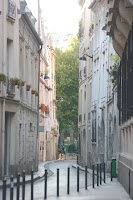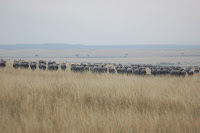Back on the road for five days now, a different state every night. We left home Saturday, after depositing Homer at Doggy Camp (because he's just not fat enough) and headed west on ... ugh ... the freeway as far as Fort Stockton; then went north through Carlsbad and Roswell to Albuquerque, where we had a short visit with my old friend Kilby, who recently moved back there from Pennsylvania. Next morning, up the road to Colorado (completing, incidentally, New Mexico on my County Count, not that that matters). I decided I'd planned too much driving for Sunday, so instead of going up to Pagosa Springs, we went into Colorado at Durango, then up the San Juan Skyway through Silverton and Ouray (where we had lunch at Billy Goat Gruff's Biergarten, with good local beer and reasonably good German food), then around the mountain to the entrance to the canyon where Telluride lies. We stopped at a place called Keystone Overlook and decided not to go into Telluride, which is just another quaint mountain resort town. Instead, we headed south and spent a good chunk of the afternoon touring Mesa Verde.
.JPG) |
| The Cliff Palace at Mesa Verde N.P. |
The entrance road to Mesa Verde National Park is one of the most dramatic drives I've ever made. You start on the plateau; ahead of you is a mesa jutting out from the higher plateau, maybe 900 or 1000 feet high. The road into the park loops into the canyon east of the promontory, then rises in a series of switchbacks until you're up on the higher plateau. From the top you can see a hundred miles, to the mountains we had been in earlier that day.
The visitors' center is fifteen miles from the park entrance. (I had no idea just how big these western parks are.) There you can arrange a place on a guided tour of several of the primary cliff-dwellings; we opted for the 5pm tour of the Cliff Palace, the largest collection of ruins in the park (which, I believe, is the largest collection of such ruins in the world). Another five miles took us to the place, where we waited on an overlook for the rest of our tour and our guide.
We, it turned out, were the entire 5pm tour, so we ended up with a private tour by Ranger Jo, a woman in her 70s who humped up and down the steep trail like a mountain goat. She pointed out a stand of wireweed and had us taste it; this was, according to her, the only "salad" the indians had. In the spring, she says, it tastes like celery; this time of year it's similar but bitter.
Ranger Jo has been around Mesa Verde a long time, and knows the history of the park from a personal point of view. That made for an interesting and occasionally idiosyncratic tour, which we enjoyed thoroughly; though I could have done with fewer reports of conversations she's had with "Grandfather," a Pueblo Indian of her acquaintance who is her primary source on points of culture. I don't know the man, but from what she told us, he is pompous about Pueblo culture to the point of arrogance, or maybe just utterly ignorant of the culture of the white people around him. (Thinking about it reminds me of a line I heard from some woman doing stand-up on the Comedy Channel: "Somebody called me a racist. That's awful. That's an awful thing to say. That's worse than calling somebody a Mexican.") Anyway, we had a nice hour-long tour and then were on our own. We drove around the park, stopping here and there to get out and see various ruins in the canyons that cover the park.
Monday morning we stopped briefly at Four Corners, a dusty third-world outpost on the Navajo reservation where four states come together. We took the obligatory photographs of ourselves standing if four states at once, had a nice chat with a couple of the stray dogs, and left.
The road west was under construction. There were crews doing resurfacing work along 100-yard-long stretches of highway, but they closed miles-long sections down to one lane to accommodate them, requiring additional personnel to drive the pilot cars. These drivers were also, apparently, in charge of passing on gossip to flagmen along the way, as we had several times to wait while our pilot exchanged pleasantries. Judging from the body language, he's an amusing conversationalist.
.JPG)
The road took us to Monument Valley, another Navajo tribal park. This one seemed much more developed on the way in, but the paved entrance and modern visitors' center and hotel proved to be just window dressing. The loop road that takes you down among the many fabulously-shaped buttes is not intended for passenger cars. (They don't tell you that at the gate, though the woman issuing our tickets was nice enough to suggest that we might want to put the top up.) The road is rocks and sand, more suited to a beat-up old Land Cruiser than a passenger car, and while I didn't bottom out, I had to attend so closely to choosing my path along this poorly-made roadway that I couldn't enjoy the scenery at all while we were moving. (I've seen better roads in the Congo.) After we'd gone about a third of the way down this 17-mile road, I decided that, since we'd already seen the major sites -- Elephant Butte, Camel Butte, the Mittens, the Three Sisters and one that looked for all the world like Droopy Dawg -- that I'd had enough, and we turned back. And got stuck in the sand.
In the Visitors' Center there's a panel talking about the creation of the park back in the 1950s, over the objection of some of the tribe. The argument that carried the day, it seems, was that if they put in a park it would keep white folk out of the rest of the Res. Every bump and rut in this pathetic road made it clear: they don't really want people to come visit. So, now that I've seen it, I'll never have to go back to the Navajo reservation. And now that I've seen Arches National Park, I won't much miss it. It ain't nothin' in comparison.
 |
| Landscape Arch |
Unfortunately, Landscape Arch is situated so that by evening it's pretty much in the shade, as you can see. Morning would have been better. Oh, well. But the next morning we went to the Delicate Arch Viewpoint, a climb of about 200 feet from the parking area. To get to the arch itself would have been twice as high a climb and three times as long a hike, so we decided not to do it. Instead we went to the areas called The Garden of Eden and The Windows, both of which were stunning no matter which way you look.
Leaving Arches yesterday morning, we drove across Utah, along one of the better freeway drives in the country -- Interstate 70 across the unusual landscape of the San Rafael Uplift -- and then onto US 50, into the Great Basin. Four years ago I had gone to the Great Basin National Park Visitors' Center to get a passport stamp, but arrived fifteen minutes after closing. My intention in planning the day's drive had simply been to try again for a stamp -- there didn't seem to be any big attraction at the park, which seems to exist only for people who like to hike and fish and stuff. But on arriving in time to get the all-important passport stamp, I found that there's a drive that goes up to view the glacier on the side of Mount Wheeler, and the ranger said it only took about 45 minutes to get up there. It was early enough in the day, so we made the drive.
I'd never seen a glacier before. Now that I've seen one, I'd kind of like to see a real one. Technically I suppose it is a glacier, this paltry patch of white stuff on the north face of the mountain, but it's hardly the kind of thing we southern boys envision when we hear the word "glacier," which usually occurs in the context of grinding out landscape for huge lakes and mountains. This thing hardly seemed adequate for two pitchers of margaritas. Guess I'll have to go to Alaska sooner than planned.
Last night we stayed in Ely, Nevada, an unimpressive little town an hour from the Great Basin park; today we drove across Nevada on US 50 (which Life Magazine once dubbed "America's Loneliest Road," recommending against driving it "unless you're confident of your skills." I guess it's been improved significantly since then, as it's a pretty good road, even through the many mountain ranges it crosses) and are now holed up for two nights in South Lake Tahoe, California. I'm really, really, really looking forward to a day of rest.
.JPG)
.JPG)
.JPG)
.JPG)
.JPG)










.jpg)